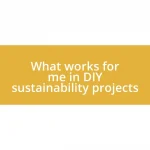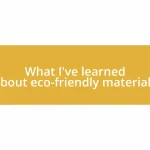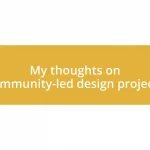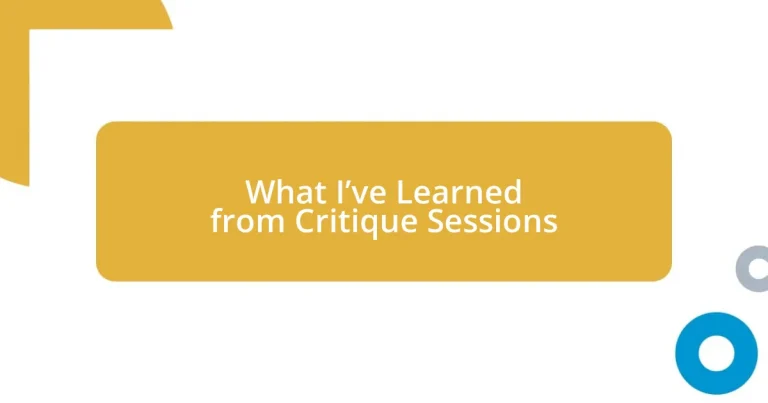Key takeaways:
- Critique sessions provide valuable insights, helping to identify both strengths and weaknesses in creative work.
- Different types of critique sessions (one-on-one, group, written) foster diverse perspectives and enhance understanding of one’s projects.
- Preparing mentally for critique with a checklist and specific feedback requests can reduce anxiety and improve the quality of feedback received.
- Implementing feedback effectively involves understanding core issues, prioritizing impactful comments, and engaging others in the revision process.
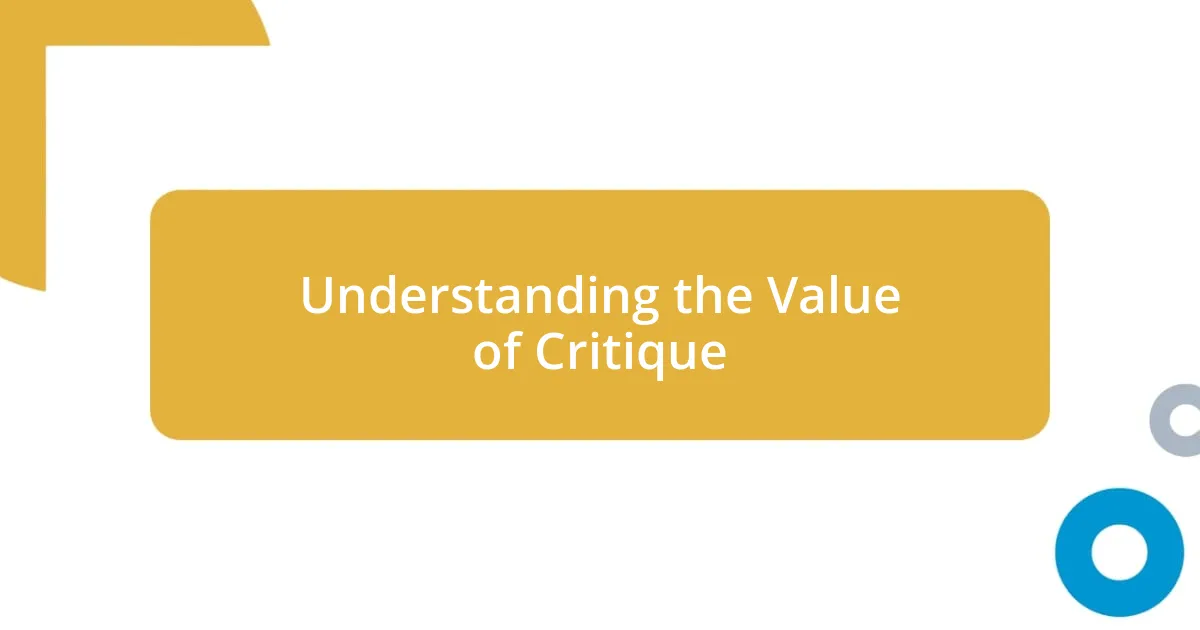
Understanding the Value of Critique
Critique sessions can feel intimidating, but I’ve learned that they are gold mines of insight. I remember my first critique; I was convinced my work was flawless. Yet, the feedback I received revealed gaps I hadn’t even considered. The process taught me that constructive criticism is not an attack; rather, it’s an invitation to grow.
When I engage in critique, I often find that different perspectives can highlight aspects of my work that I might overlook. It’s like having a pair of fresh eyes that see the flaws while also recognizing the strengths. Have you ever noticed how feedback can spark ideas you hadn’t thought to explore? For me, those “aha” moments make the effort worthwhile.
Understanding the value of critique goes beyond just improving a project; it builds resilience. Each time I receive feedback, it nudges me to detach my ego from my work. I’ve learned that every piece of critique is an opportunity to refine my voice and style, ultimately evolving my creative process. Isn’t it fascinating how something that feels like a setback can actually propel us forward?
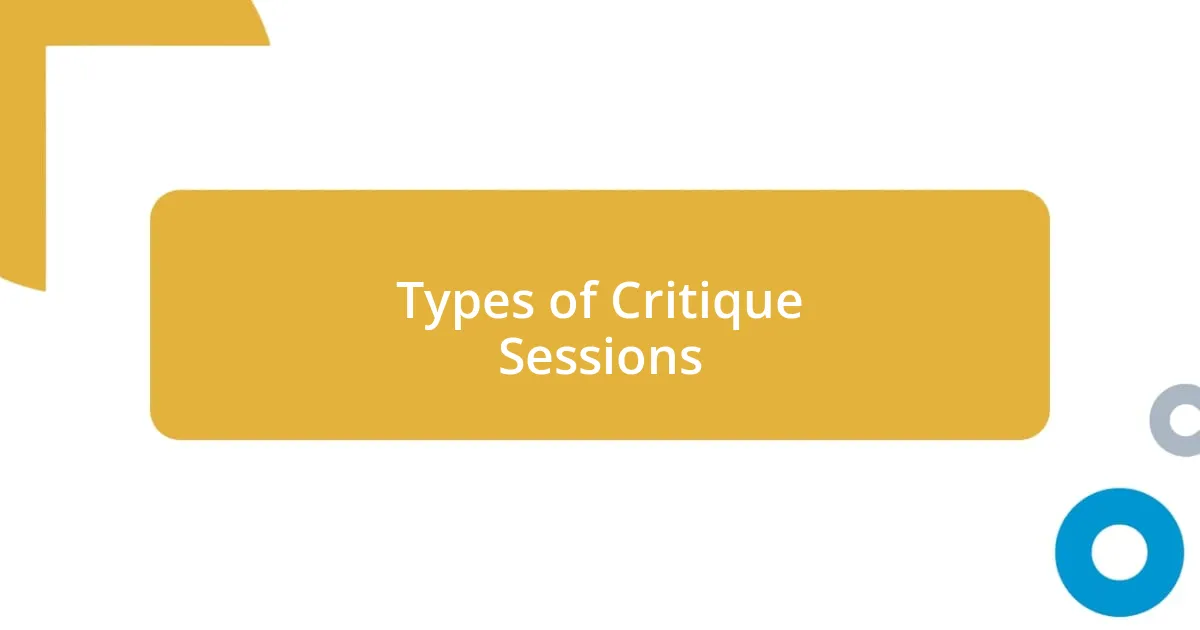
Types of Critique Sessions
Critique sessions come in various formats, each offering unique benefits. Personally, I’ve found that group critiques foster a dynamic exchange of ideas. When multiple voices contribute, I often discover unexpected interpretations of my work. It’s exhilarating to witness firsthand how diverse viewpoints can reshape my understanding of my own creations.
Here’s a breakdown of different types of critique sessions that I’ve encountered:
-
One-on-One Sessions: These private meetings provide focused feedback. They allow for in-depth discussions, and I appreciate the opportunity to ask questions directly.
-
Group Critiques: In groups, the mix of perspectives creates a richer dialogue. I remember a session where a colleague’s observation completely shifted my project’s direction, leading to far more innovative results.
-
Written Critiques: Receiving feedback in written form allows me to reflect at my own pace. I often find that revisiting these comments later reveals layers I might have missed initially.
-
Informal Peer Reviews: Sometimes casual conversations over coffee yield the most insightful critique. I once shared a draft with a friend, and their casual remark pushed me to think differently about the narrative arc.
-
Formal Portfolio Reviews: These are often structured and involve professionals in the field. I was nervous during my first portfolio review, but the constructive feedback propelled me into a more professional mindset.
Each type has its place in the creative process, and I value the lessons learned from each experience.
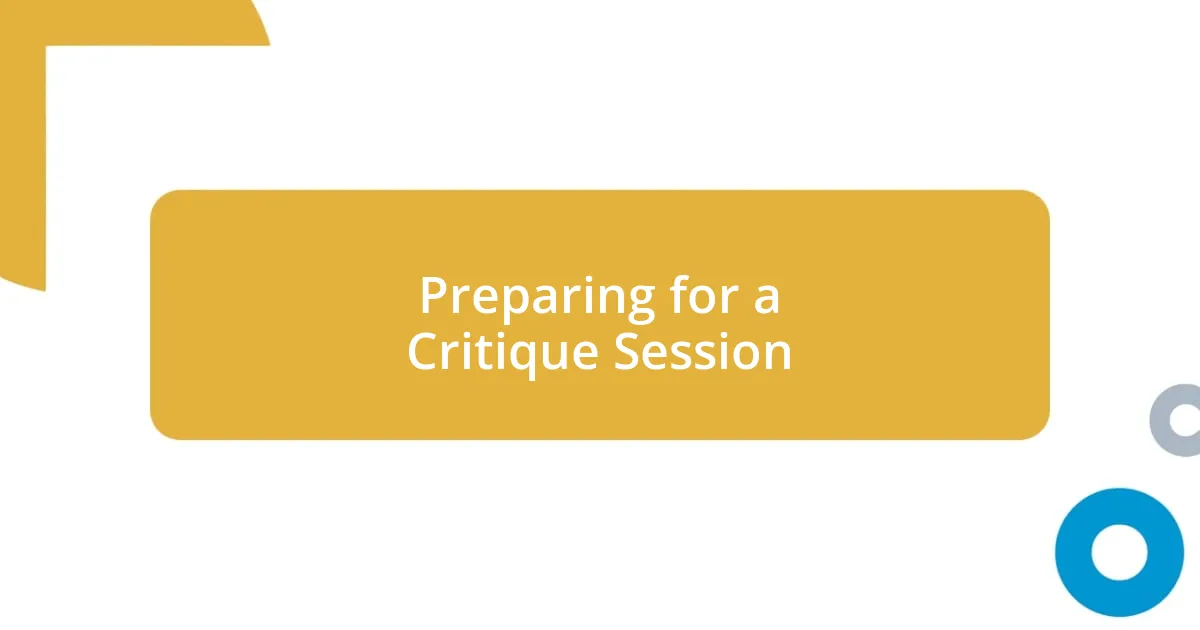
Preparing for a Critique Session
Preparing for a critique session requires a bit of mental fortitude. I remember feeling butterflies in my stomach before my first one; I thought it was just me. But over time, I realized that everyone feels a bit vulnerable when putting their work in the spotlight. What worked for me was creating a checklist of materials to prepare, ensuring I was equipped with everything from my project drafts to notes on specific areas where I wanted feedback. Having a plan helped me feel more in control, which made the critique feel less daunting.
I also find it beneficial to clarify what kind of feedback I’m seeking beforehand. For instance, at one of my earlier critique sessions, I simply asked for general feedback and ended up overwhelmed with suggestions. After that experience, I started pinpointing specific aspects I wanted critique on, like character development or pacing. When I framed my request more clearly, the responses became much more focused and actionable. This shift not only guided feedback but also allowed me to engage more deeply with my critics.
Finally, I think it’s essential to adopt a receptive mindset as I enter the critique room. I consciously remind myself that criticism is not personal and can be genuinely beneficial. One memorable session stands out where I entered a bit defensive. It turned into a transformative experience when I shifted my perspective and embraced the critiques. The result was an enriched project that surpassed my initial vision. How about you—have you ever walked into a session with your guard up, only to leave inspired?
| Preparation Strategies | Impact on Experience |
|---|---|
| Create a Checklist | Increases control and reduces anxiety |
| Clarify Feedback Focus | Produces actionable insights |
| Adopt a Receptive Mindset | Encourages transformation and inspiration |
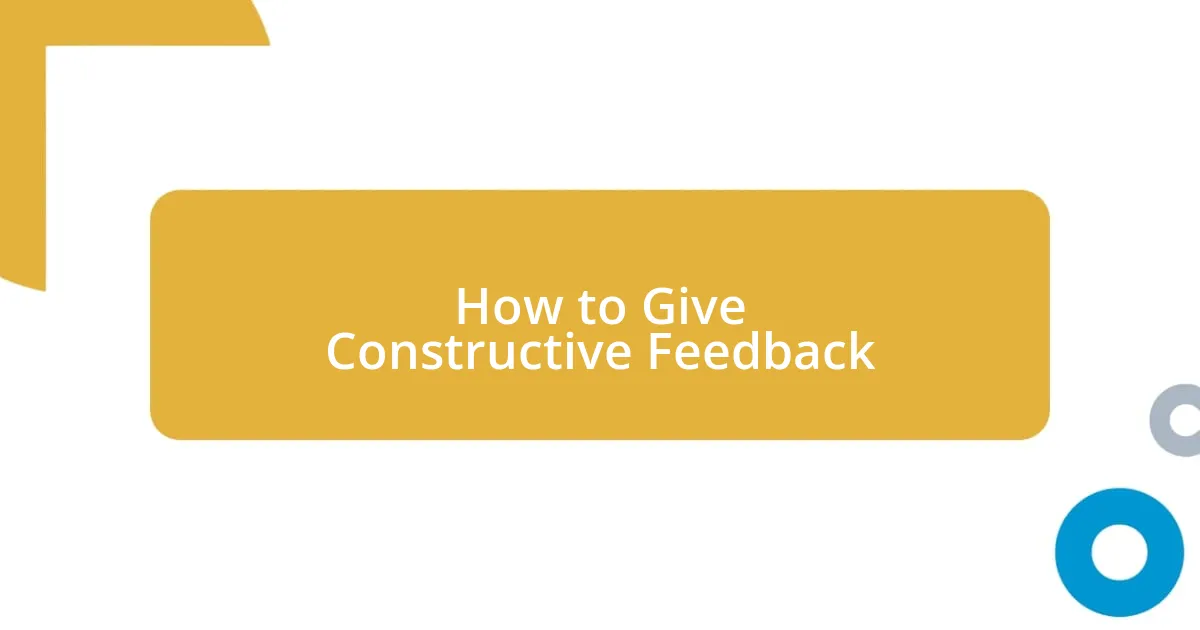
How to Give Constructive Feedback
Giving constructive feedback is an art that I’ve come to appreciate over time. I’ve learned that being specific is key; instead of saying, “I didn’t like this part,” it’s much more helpful to explain why. For example, I remember critiquing a friend’s story where a character felt flat. I didn’t just say that—I pointed out where the character’s motivations weren’t clear. This clarity not only helped my friend understand my perspective but also opened up a more engaging dialogue.
I also find it crucial to balance critique with praise. When I first started giving feedback, I tended to focus on what needed improvement, which could feel discouraging for those receiving it. Then, I shifted my approach by starting with what I appreciated about the work. I recall a session where I complimented a colleague’s vibrant use of imagery before diving into the areas for growth. That small adjustment made the entire critique feel more like a collaborative improvement process rather than a list of flaws.
Lastly, I pay attention to my tone and body language while providing feedback. In one session, I noticed my relaxed posture and warm tone made a colleague more receptive to my suggestions. It’s all about creating an environment where they can feel safe and open to discussion. Have you ever experienced a critiquing atmosphere that just clicked? I believe when feedback is paired with a supportive attitude, it becomes a powerful tool for growth.
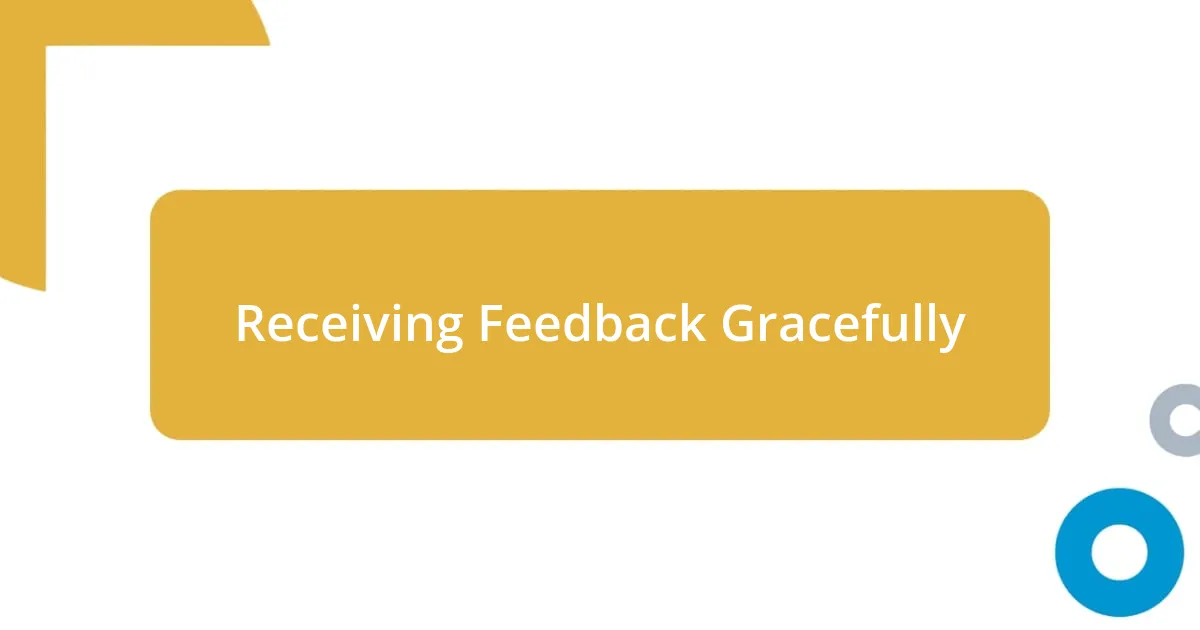
Receiving Feedback Gracefully
Receiving feedback gracefully is truly an art. In one of my earlier critique sessions, I remember sitting there, feeling my heart race as my work was dissected piece by piece. Initially, I was defensive—every comment felt like a personal attack. But then I took a deep breath and reminded myself that these were not critiques of my abilities; rather, they were insights aimed at making my work better. That shift in perspective helped me to listen more openly.
I also learned to embrace silence in these moments. There was a critique where I found myself wanting to jump in and explain or defend my choices after every piece of feedback. But I’ve realized that sometimes, just sitting with the feedback for a moment allows me to process it fully. It’s like marinating in the comments—it gives me time to digest the thoughts being shared and to think about how they align with what I envisioned. Has anyone else experienced this? The power of silence can lead to some of the most profound insights.
Lastly, showing appreciation toward my critics has transformed my experience. I once attended a session where, after receiving potentially harsh feedback, I responded with gratitude. I saw how that simple gesture shifted the tone of the conversation. Instead of lingering on defensiveness, I engaged in a constructive dialogue where we explored each suggestion together. I now believe that recognizing others’ efforts in providing feedback not only builds rapport but also creates an atmosphere of mutual respect. How has your approach to receiving feedback evolved over time?
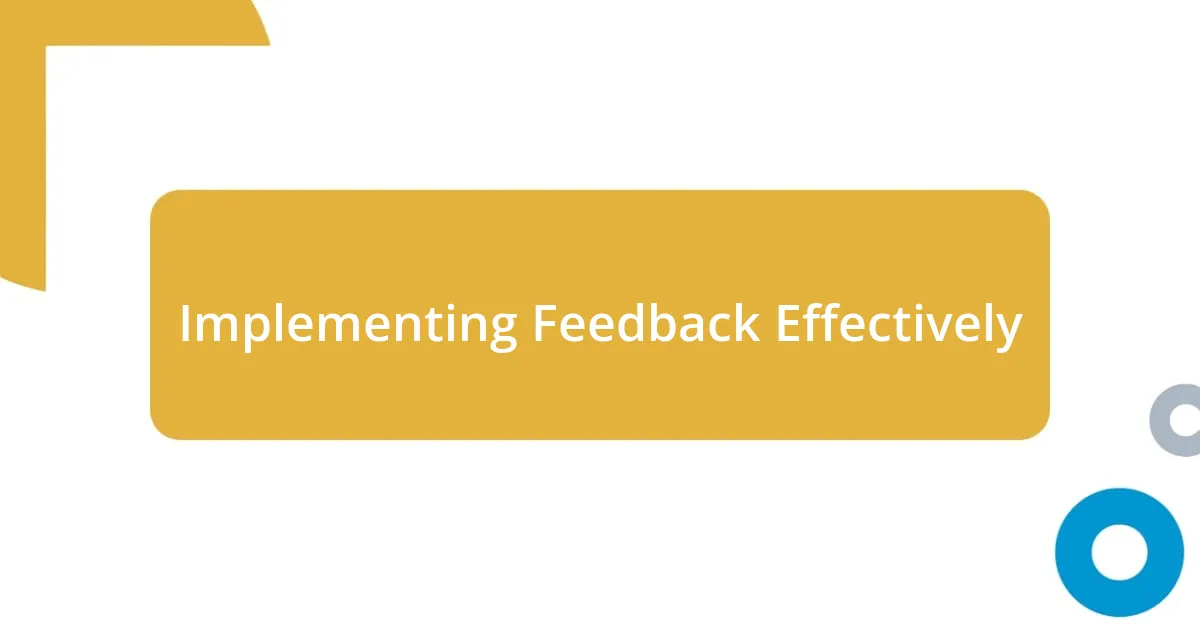
Implementing Feedback Effectively
Effective implementation of feedback is not just about making changes; it’s about truly understanding the underlying message behind the critique. I remember a time when I received feedback on a project that felt overwhelming at first. Instead of simply tweaking the elements suggested, I took a step back to analyze the core issues. By identifying the root of each comment, I was able to create a more cohesive result that resonated better with the audience. Have you ever felt lost in feedback? Taking that extra moment to reflect can lead to profound transformations in your work.
One strategy that has worked wonders for me is prioritizing feedback based on its impact. There was a project where I received a flurry of comments—some were minor, while others fundamentally altered my perspective. I chose to address the major points first, which provided a clearer path for my revisions. This method not only reduced my initial overwhelm but also allowed me to maintain the essence of my vision. Isn’t it interesting how focusing on what truly matters can make the entire process feel lighter?
Lastly, I find involving others in the implementation process to be invaluable. After receiving feedback, I often reach out to a few trusted friends or colleagues to brainstorm solutions collectively. Not long ago, I was revising a piece that had received mixed reviews. By discussing the comments and involving others in my thought process, I discovered new insights and angles I hadn’t considered. How often do you collaborate on the feedback you receive? Engaging others not only enriches your work but also creates a sense of community and shared growth.
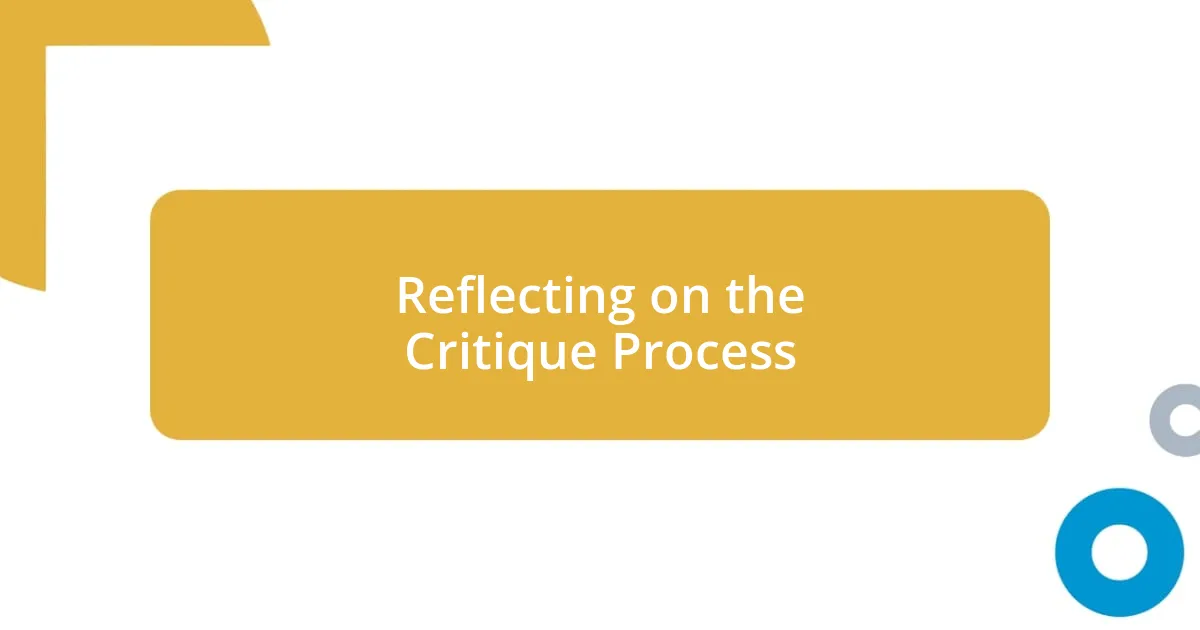
Reflecting on the Critique Process
Reflecting on the critique process often leads to unexpected revelations. I vividly recall a critique session where I thought I would just hear edits and suggestions. However, as the discussion unfolded, I realized it was about peeling back layers of my work that I hadn’t fully explored. This experience taught me that the critique isn’t just an assessment—it’s a collaborative investigation into my creative choices. How often do we overlook the depth of meaning in our creations when we become too attached?
Throughout my journey, I learned that reflecting on feedback involves not just the comments but also my emotional reactions. During one particular session, I felt a wave of frustration at certain critiques, which initially clouded my judgment. But after allowing myself to sit with those feelings, I understood that my defensiveness stemmed from a fear of vulnerability. This emotional clarity helped me refocus on the constructive aspects of the feedback. Has anyone else noticed how powerful emotions can shape our perceptions in these settings?
With each critique I’ve engaged in, I’ve started to value the entirety of the process, not just the outcomes. I now view it as an opportunity for growth rather than a simple evaluation. Recently, I attended a session where other participants openly shared their struggles, and it resonated deeply with me. I realized we are all navigating our own challenges, and this shared vulnerability creates a unique connection. Have you found that authentic sharing in critique settings fosters a stronger sense of community? Reflecting on this has transformed how I participate, shifting my focus from individualism to collective improvement.

